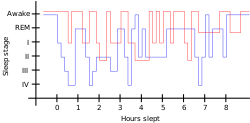Restless legs syndrome

Editor-In-Chief: Prab R Tumpati, MD
Obesity, Sleep & Internal medicine
Founder, WikiMD Wellnesspedia &
W8MD medical weight loss NYC and sleep center NYC
| Restless legs syndrome | |
|---|---|

| |
| Synonyms | Willis-Ekbom disease |
| Pronounce | N/A |
| Specialty | N/A |
| Symptoms | Uncomfortable sensation in legs, urge to move legs |
| Complications | N/A |
| Onset | Any age, but more common in middle-aged and older adults |
| Duration | Long-term |
| Types | N/A |
| Causes | Often unknown, sometimes iron deficiency, kidney failure, pregnancy, Parkinson's disease |
| Risks | Family history, pregnancy, iron deficiency |
| Diagnosis | Based on symptoms, polysomnography |
| Differential diagnosis | Peripheral neuropathy, arthritis, leg cramps |
| Prevention | N/A |
| Treatment | Lifestyle changes, medications such as dopamine agonists, gabapentin |
| Medication | Dopamine agonists, gabapentin, opioids |
| Prognosis | N/A |
| Frequency | 5-10% of adults |
| Deaths | Not directly fatal |
Restless Legs Syndrome (RLS) is a long-term disorder characterized by a strong urge to move one's legs, often accompanied by unpleasant sensations such as aching, tingling, or crawling. Occasionally, arms may also be affected. These sensations typically occur when at rest and can make it difficult to sleep. As a result, people with RLS may experience daytime sleepiness, low energy, irritability, and a depressed mood. Limb twitching during sleep is also common in individuals with RLS.
Signs and Symptoms[edit]
Primary and Secondary[edit]
- Strong urge to move legs, usually accompanied by uncomfortable sensations
- Symptoms worsen during periods of rest or inactivity
- Relief from symptoms with movement
- Symptoms are more severe in the evening or at night
- Involuntary limb twitching during sleep
Causes[edit]
The exact cause of RLS is still not well understood, but it is believed to involve a combination of genetic, environmental, and lifestyle factors.
ADHD[edit]
There is evidence suggesting a link between RLS and Attention Deficit Hyperactivity Disorder (ADHD), with both conditions sharing common neurological pathways and dopamine imbalances.
Medications[edit]
Certain medications, such as antidepressants, antipsychotics, and some antihistamines, can exacerbate or trigger RLS symptoms.
Genetics[edit]
Genetic factors play a role in RLS, with multiple genes associated with an increased risk of developing the disorder.
Mechanism[edit]
Although the exact mechanism of RLS is not fully understood, it is believed to involve an imbalance of dopamine, a neurotransmitter that plays a crucial role in regulating movement and mood.
Diagnosis[edit]
Differential Diagnosis[edit]
The diagnosis of RLS is primarily based on a detailed clinical evaluation, including a thorough medical history and physical examination. The following diagnostic criteria are typically used to diagnose RLS:
- A strong urge to move the legs, usually accompanied by uncomfortable sensations
- Symptoms worsen during periods of rest or inactivity
- Relief from symptoms with movement
- Symptoms are more severe in the evening or at night
- Additional tests, such as blood tests or sleep studies, may be ordered to rule out other conditions or identify underlying causes.
Treatment[edit]
Treatment for RLS aims to alleviate symptoms, improve sleep quality, and address any underlying causes.
Physical Measures[edit]
- Regular exercise
- Stretching and massage
- Hot or cold packs
- Good sleep hygiene
Iron[edit]
If iron deficiency is identified as an underlying cause, supplementation or dietary changes may be recommended to increase iron levels.
Medications[edit]
- Dopaminergic agents (e.g., pramipexole, ropinirole, rotigotine)
- Benzodiazepines (e.g., clonazepam)
- Opioids (e.g., tramadol, oxycodone)
- Anticonvulsants (e.g., gabapentin, pregabalin)
Prognosis[edit]
The prognosis for RLS varies from person to person, with some individuals experiencing mild symptoms that can be easily managed, while others may have more severe symptoms that significantly impact their quality of life. However, with appropriate treatment, many people with RLS can achieve symptom relief and improved sleep quality.
Epidemiology[edit]
RLS affects approximately 5-15% of the general population, with a higher prevalence in women and individuals of middle age or older. The condition can begin at any age but is more common in adults.
History[edit]
Nomenclature[edit]
RLS was first described by Sir Thomas Willis in 1672, but the term "restless legs syndrome" was not coined until 1945 by Swedish neurologist Karl-Axel Ekbom. Since then, the understanding of RLS has evolved significantly, with ongoing research into its causes, mechanisms, and treatment options.
Controversy[edit]
There has been some controversy surrounding the classification and diagnosis of RLS. Some critics argue that the condition is overdiagnosed or that the diagnostic criteria are too broad, leading to the potential for misdiagnosis or unnecessary treatment.
Research[edit]
Current research on RLS is focused on improving the understanding of its underlying causes, identifying more effective treatment options, and exploring potential preventive measures. Studies have investigated the role of iron and dopamine in the development of RLS, as well as the relationship between RLS and other conditions such as ADHD, sleep apnea, and cardiovascular disease.
External links[edit]
- Restless Legs Syndrome Foundation
- National Institute of Neurological Disorders and Stroke: Restless Legs Syndrome Fact Sheet
- National Sleep Foundation: Restless Legs Syndrome
| Diseases of the nervous system, primarily CNS (G04–G47, 323–349) | ||||||||||||||||||||
|---|---|---|---|---|---|---|---|---|---|---|---|---|---|---|---|---|---|---|---|---|
|
Tired of Being Overweight?[edit]
Achieve lasting results with W8MD's proven weight loss program, trusted by thousands since 2011. Our comprehensive approach tackles weight gain factors like insulin resistance to help you lose weight and keep it off.

Tailored Weight Loss Solutions[edit]
W8MD offers personalized weight loss plans, including FDA-approved medications and GLP-1 injections, such as:
Other options include:
We also offer nutritious, low-glycemic foods and meal replacements to keep you on track.
Convenient Locations[edit]
W8MD provides weight loss services in Brooklyn, New York and Greater Philadelphia, with tailored plans and GLP-1 weight loss injections.
Looking for a weight loss clinic in Brooklyn or weight loss doctors in NYC? W8MD's expert team is here to help.

Weight Loss Doctor in NYC[edit]
Trust W8MD's best weight loss doctors in NYC for personalized solutions, including wiki Physician Weight Loss Program and GLP-1 injections.
W8MD Weight Loss Clinic in Philadelphia[edit]
W8MD in Philadelphia offers FDA-approved medications and weight loss injections. Visit our medical weight loss clinic for expert care.
Find the best weight loss tips in Philadelphia with W8MD.
Take the First Step[edit]
Book your consultation today and start your journey:
- Visit W8MD Official Site
- Check out Yelp reviews
- Schedule via Patient Fusion
Call now for medical weight loss:
- NYC: 718-946-5500
- Philadelphia: 215-676-2334
Explore W8MD's NYC Physician Weight Loss Program now!
- Individual results may vary!
Ad. Transform your life with W8MD's Budget GLP-1 injections from $75


W8MD offers a medical weight loss program to lose weight in Philadelphia. Our physician-supervised medical weight loss provides:
- Weight loss injections in NYC (generic and brand names):
- Zepbound / Mounjaro, Wegovy / Ozempic, Saxenda
- Most insurances accepted or discounted self-pay rates. We will obtain insurance prior authorizations if needed.
- Generic GLP1 weight loss injections from $75 for the starting dose.
- Also offer prescription weight loss medications including Phentermine, Qsymia, Diethylpropion, Contrave etc.
NYC weight loss doctor appointmentsNYC weight loss doctor appointments
Start your NYC weight loss journey today at our NYC medical weight loss and Philadelphia medical weight loss clinics.
- Call 718-946-5500 to lose weight in NYC or for medical weight loss in Philadelphia 215-676-2334.
- Tags:NYC medical weight loss, Philadelphia lose weight Zepbound NYC, Budget GLP1 weight loss injections, Wegovy Philadelphia, Wegovy NYC, Philadelphia medical weight loss, Brookly weight loss and Wegovy NYC
|
WikiMD's Wellness Encyclopedia |
| Let Food Be Thy Medicine Medicine Thy Food - Hippocrates |
Medical Disclaimer: WikiMD is not a substitute for professional medical advice. The information on WikiMD is provided as an information resource only, may be incorrect, outdated or misleading, and is not to be used or relied on for any diagnostic or treatment purposes. Please consult your health care provider before making any healthcare decisions or for guidance about a specific medical condition. WikiMD expressly disclaims responsibility, and shall have no liability, for any damages, loss, injury, or liability whatsoever suffered as a result of your reliance on the information contained in this site. By visiting this site you agree to the foregoing terms and conditions, which may from time to time be changed or supplemented by WikiMD. If you do not agree to the foregoing terms and conditions, you should not enter or use this site. See full disclaimer.
Credits:Most images are courtesy of Wikimedia commons, and templates, categories Wikipedia, licensed under CC BY SA or similar.
Translate this page: - East Asian
中文,
日本,
한국어,
South Asian
हिन्दी,
தமிழ்,
తెలుగు,
Urdu,
ಕನ್ನಡ,
Southeast Asian
Indonesian,
Vietnamese,
Thai,
မြန်မာဘာသာ,
বাংলা
European
español,
Deutsch,
français,
Greek,
português do Brasil,
polski,
română,
русский,
Nederlands,
norsk,
svenska,
suomi,
Italian
Middle Eastern & African
عربى,
Turkish,
Persian,
Hebrew,
Afrikaans,
isiZulu,
Kiswahili,
Other
Bulgarian,
Hungarian,
Czech,
Swedish,
മലയാളം,
मराठी,
ਪੰਜਾਬੀ,
ગુજરાતી,
Portuguese,
Ukrainian